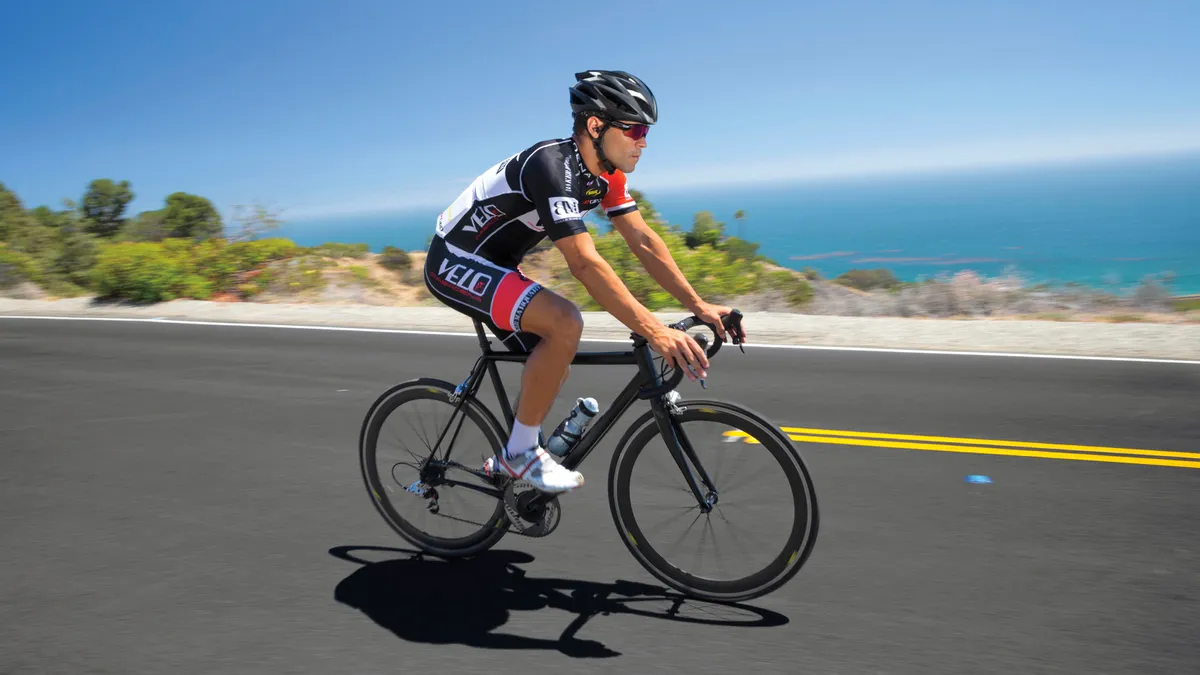This is a sponsored article in association with Oakley.
Unless you’re a professional athlete, it’s a surefire bet that you’re juggling sport with work, family and whatever else squeezes your busy schedules. That’s where these eight cutting-edge training, gear and nutrition tips come in. They’re not designed to pile extra training onto your already overworked bodies; instead, they’re replacements that won’t take up more time but will result in significant improvements.
Try them all or cherry-pick the ones that truly pique your interest. You’ll soon be chasing a new PB, while your rivals chase your shadow…
1. Glycogen-depleted training
‘Training fasted’ is a popular session utilised by professional athletes and involves training when your glycogen stores (how your body stores excess glucose, primarily in the muscles and liver cells) are low.
The idea is that you’ll switch from burning precious glycogen stores to more plentiful fat stores. Ultimately, this means you can bike or run longer and faster.
There are various ways to train fasted but the least taxing is what’s called a ‘riser session’. Essentially, this is the first workout of the day where you’re fuelled on water or a caffeinated drink after an overnight fast.
2. Eat high-cocoa chocolate
Many professional cyclists confess that their nutritional sin is chocolate. “That’ll slow them down,” you might holler! Well, maybe not. According to sports scientist and professional road cyclist Lieselot Decroix, who’s currently studying the effects of dark chocolate on altitude training, “there’s clear evidence that consuming chocolate with enriched cocoa can make you a better athlete”.
Why is down to the flavanol ‘epicatechin’ that’s swimming in chocolate with a very high cocoa content. How does it work? Epicatechin triggers the muscles in the arterial wall to relax. This raises bloodflow, which increases delivery of oxygen and nutrients to all organs.
3. 21st-Century bike fit
A bike fit by a reputable practitioner will cost upwards of £100 but is money well spent. Your fitter will ensure you’re in the perfect position to not only maximise power and comfort, but also to reduce chances of injury.
Expect changes to saddle height and fore-aft position; you might have spacers removed or added on your stem to raise or lower your position; and a recommendation of a longer or shorter stem depending on reach.
Just remember that your new position will draw you to the bike even more, resulting in a leaner, fitter you. That’s why it’ll be worth revisiting the bike-fitter a year down the line in case your position needs tweaking.
4. Double planning
Dave Scott won Ironman Hawaii a record six times and has developed into one of the world’s best triathlon coaches, teaching elite and age-groupers alike. Scott understands the challenges of consistent training when balancing life, work, family and endurance sport, so says you should not only write down when you intend to train, but also an alternative spot if you can’t make the original time.
“It doesn’t matter if this is a 40-minute session instead of an hour,” Scott says. “It’s still better than nothing.”
5. Oakley Radar Pace
Data is knowledge and knowledge is power, and that’s exactly what you get with Oakley’s new Radar Pace performance eyewear.
While the lenses and frame offer the same visual and comfort standards you’d expect of Oakley, it’s the smart technology that elevates this game-changer above the competition.
A Virtual Coach is powered by Intel Real Speech, which is why earbuds and a microphone are integrated into the ergogenic design.

You ask the coach a question – “What speed am I running at?” for instance – and your coach will tell you in real-time.
The Radar Pace pairs with myriad of training tools, like power meters, heart rate monitors and cadence sensors, to track, analyse and relay how your session is progressing.
The Virtual Coach also creates a six-to14-week training plan customised to you, and automatically adjusts for missed workouts. In short, this is the most innovative wearable technology around.
6. Circadian training
Researchers have concluded that the best time to train is… drum roll, please … 5pm. Athletes were split into groups with both sets undertaking 24 weeks of strength and endurance training, though one ticked off their sessions in the morning and the other later in the afternoon. Come week 24, the evening group exhibited greater muscle-mass gains than the morning group.
Reasons mooted include core temperature is elevated later on, leading to more efficient muscular contraction. There’s also evidence that motivation to undertake rigorous physical exercise is linked with the body’s core temperature.
7. Sleep easy, race fast
Sleep is the most neglected part of the performance equation but possibly the most important. Why is heavily down to testosterone.
The hormone, which stimulates muscle and tissue growth, is released during the deeper stages of sleep. Fail to get enough sleep and you’ll restrict gains from the previous training session.
If you are one of the 50% who doesn’t enjoy enough sleep, try the following: cut back coffee intake to a maximum two cups per day and ideally none after lunch; don’t eat late as digestion slows down during sleep, meaning you’ll just feel bloated; and steer away from exercising just before bed as stress hormones rise during training, preventing you from drifting off.
8. Picture success
“All top athletes engage in visualisation,” says Ian Robertson, professor of psychology at Trinity College, Dublin. “They mentally go through their routines beforehand to more accurately prepare them for the upcoming race.”
If you think this is whimsical nonsense, neuroscience supports the benefits with studies revealing that almost all the parts of the brain that are active when you’re actually undertaking an activity are active when you’re imagining it. It’s only the final pathways that aren’t activated.
As mentally running through a whole race would actually be exhausting in itself, instead focus for 5-10mins a day in the race build-up on a key section. This could be a technical descent or a taxing hill.

